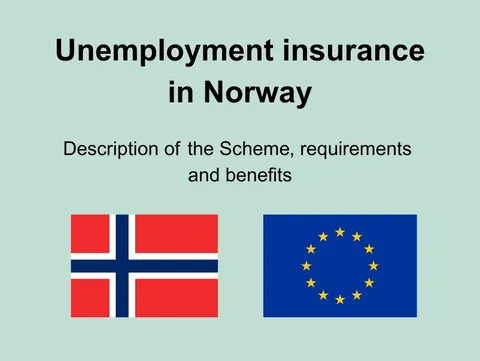EU
Norway
Unemployment
Insurance
Unemployment Insurance in EU->Norway
Unemployment insurance in Norway
This article provides information about who is entitled to unemployment benefit (dagpenger under arbeidsløshet), and what conditions apply to the benefit.
Regarding the UK the EEA/EFTA-UK Separation Agreement or the Convention on Social Security Coordination between Iceland, the Principality of Liechtenstein, the Kingdom of Norway and the United Kingdom of Great Britain and Northern Ireland is applied.
In what situation can I claim?
You may be entitled to unemployment benefit if you have become wholly unemployed, or if your working hours have been reduced by at least 50%. If it is your own fault that you are unemployed, there will be a waiting time of at least twelve weeks before any unemployment benefit can be paid.
What conditions do I need to meet?
You must either have had an income from paid work (pay) of at least 1.5 the Basic Amount (Grunnbeløpet) i.e. NOK 177 930 in the preceding 12 months, or at least 3 times the Basic Amount, i.e. NOK 355 860 during the 36 preceding months.
If you are an EEA citizen and have become unemployed in Norway without having earned this sufficient minimum income, you may still be entitled to unemployment benefit on the basis of work in another EEA country. In this instance you would be required to have worked the equivalent of full time for at least 16 weeks in another EEA country during the previous 23 months, or at least 32 weeks during the last 36 months.
It is a fundamental requirement that you must be a genuine job-seeker, i.e. willing and able to take any work, anywhere in Norway. You must be registered with NAV as a job-seeker and you may be required to document your job-seeking activities. If you refuse to take a suitable job, do not attend the NAV office when you are asked to, or are not actively looking for work, you may lose your entitlement to unemployment benefit for a period.
What am I entitled to and how can I claim?
Unemployment benefit amounts to 62.4% of your previous income. Certain social security benefits that directly replace salary are included in the figure used for this calculation, e.g. sickness benefit, parental benefit and unemployment benefit. The highest figure that can be used is 6 G, i.e. NOK 711 720 at the current Basic Amount, which means that any income that exceeds 6 G will not be included when your unemployment benefit is calculated.
You will be paid 0.24% of the figure, 5 days per week. The table below shows examples of income and the corresponding unemployment benefit.
| Gross pay NOK | 200,000 | 300,000 | 400,000 | 581,000 | 700,000 | 1,000,000 |
| Gross benefit NOK | 124,800 | 187,200 | 249,600 | 362,543 | 362,543 | 362,543 |
If you are providing for one or more children under the age of 18, a fixed supplement of NOK 35 per day will be paid.
Unemployment benefit is classed as taxable income.
In order to receive unemployment benefit, you must apply electronically via NAV's website, or via a form which you submit to your local NAV office. Once you have fulfilled the conditions and the unemployment benefit has been granted, a deductible equivalent to three days’ unemployment benefit will be deducted from the first payment(s).You must also report to NAV every 14 days, either electronically or using the employment status form; this includes confirming your status as a job-seeker. Unemployment benefit is paid in arrears every 14 days, once your job-seeking activities have been approved. Work, illness or any other reason why you cannot be regarded as a genuine job-seeker will result in a reduction or discontinuation of your unemployment benefit.
If you had an income from work of at least 2 G, i.e. NOK 237 240 at the current Basic Amount, you are entitled to unemployment benefit for up to 104 weeks. If your income was less than 2 G, you are entitled to unemployment benefit for up to 52 weeks.
Jargon busters
- G: Abbreviation for National Insurance Basic Amount (see Basic Amount below). 1 G = 1 x Basic Amount, 2 G = 2 x Basic Amount, etc.
- Basic Amount: A standard amount that is used to calculate benefits and pensions, and which is set on 1 May each year. As of 1 May 2023, the Basic Amount is NOK 118 620, or about EUR 10 532.
Forms you may need to fill in
- Søknad om attest utstedelse av PD UD (application to receive unemployment benefit in another EEA country) Opphold eller arbeid utenfor Norge - www.nav.no (in Norwegian only)
Know your rights
The links below direct you to websites that describe your legal rights.
- Unemployment benefit while unemployed - National Insurance Act (in Norwegian only)
- Your rights as a member of the National Insurance Scheme
Who do you need to contact?
NAV: Via NAV's website Contact us - nav.no
This page was last updated in 2024.
- Unemployment insurance in Europe →
Unemployment Insurance in Norway
You might also be interested in:
⇒EU social security coordination
⇒Unemployment Insurance in the Nordic countries
Key points of EU Unemployment Insurance coordination
- Transferring periods of work and insurance between EEA countries As an EU citizen you can transfer acquired rights from Unemployment Insurance when moving between EU/EEA contries. In this way it may be easier to become entitled to unemployment benefit in the country you move to.
In the vast majority of the Member states the aggregation rule become fully applicable as soon as you starts to work in the country. However in Denmark, Belgium and Finland you must work some period there before you can use the aggregation rule.
You need a PD U1 document in the country you leave or if the involved countries use electronically exhange (EESSI) there will be issued a SED U002. The countries who issues the highest number of PD U1 documents are Germany, Austria, Switzerland and the Netherlands. The countries who receives most PD U1 documents are Lithuania and Italy. - Transferring unemployment benefits Under certain conditions you can go to another EU country to look for work and continue to receive your unemployment benefits from the country where you became unemployed. The period you can export your unemployment benefits varies from 3 to 6 months in the different Member states.
You have to apply for a PD U2 document in the country you leave, or if you haven't done that the institution in the receiving country must request a SED U008 from the competent institution in your last country.
The countries who issues the highest number of PD U2 documents are Germany, Switzerland, the Netherlands and Denmark. Poland is the country who receives by far most PD U2 documents. - Unemployment benefits coverage According to OECD the net replacement of income after 2 months of unemployment, for a single person without children whose previous in-work earnings were 67% of the average wage varies from 33 percent (Ireland) to 91 percent (Belgium). Read more here..
- Having residence in another EU country than where you work? According to EU social security coordination rules you must only be insured against unemployment in one country at a time. As a generel rule this country is where you work.
In Member states who have compulsory insurance, you will automatically be covered when you start working there.
However you may be insured by your country of residence if you are posted to a EU/EEA country or work in two or more EU/EEA countries at a time. In these situations you can not your self decide where to have unemployment Insurance, but you (or your employer) must apply for a PD A1 document which states in which country you are covered by social security, including Unemployment Insurance. Special rule also apply for cross-border workers ("frontier workers"). - Third-country Nationals working in EU/EEANON-EEA citizens are covered by Unemployment Insurance in the EU countries who have compulsory Unemployment Insurance. In countries with voluntary Unemployment Insurance (Denmark, Sweden and Finland) third-country nationals can become member of an Unemployment Insurance Fund.
In the most countries Third-country nationals can also use the EU Coordination rules when moving within EU/EEA (however not in Denmark, Iceland, Liechtenstein, Norway and Switzerland).
Third-country nationals in short-tem working relations often faces problems with actually get Unemployment benefits, even though they have contributed to the system. This is due to the fact that one normally need a residence permit which allow one to take any job, and also because of a qualifying period in most countries between 6-12 months.

